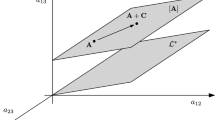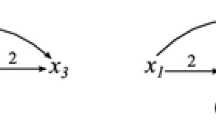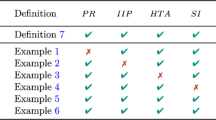Abstract
We propose a unifying approach to the problem of measuring the inconsistency of judgments. More precisely, we define a general framework to allow several well-known inconsistency indices to be expressed as special cases of this new formulation. We consider inconsistency indices as aggregations of ‘local’, i.e. triple-based, inconsistencies. We show that few reasonable assumptions guarantee a set of good properties for the obtained general inconsistency index. Under this representation, we prove a property of Pareto efficiency and show that OWA functions and t-conorms are suitable aggregation functions of local inconsistencies. We argue that the flexibility of this proposal allows tuning of the index. For example, by using different types of OWA functions, the analyst can obtain the desired balance between an averaging behavior and a ‘largest inconsistency-focused’ behavior.





Similar content being viewed by others
Notes
A similar property, called locality, was formulated in “W.W. Koczkodaj and J. Szybowski, Axiomatization of inconsistency indicators for pairwise comparisons matrices revisited, arXiv:1509.03781v1”.
References
Aczél, J., & Saaty, T. L. (1983). Procedures for synthesizing ratio judgments. Journal of Mathematical Psyshology, 27(1), 93–102.
Aguarón, J., Escobar, M. T., & Moreno-Jiménez, J. M. (2016). The precise consistency consensus matrix in a local AHP-group decision making context. Annals of Operations Research, 245(1–2), 245–259.
Aguarón, J., & Moreno-Jiménez, J. M. (2003). The geometric consistency index: Approximated thresholds. European Journal of Operational Research, 147(1), 137–145.
Beliakov, G., Pradera, A., & Calvo, T. (2007). Aggregation functions: A guide for practitioners, studies in fuzziness and soft computing (Vol. 221). Berlin: Springer.
Belton, V., & Stewart, T. J. (2002). Multiple criteria decision analysis: An integrated approach. Boston: Kluwer Academic Publishers.
Bozóki, S., Fülöp, J., & Rónyai, L. (2010). On optimal completion of incomplete pairwise comparison matrices. Mathematical and Computer Modelling, 52(1–2), 318–333.
Bozóki, S., & Rapcsák, T. (2008). On Saaty’s and Koczkodaj’s inconsistencies of pairwise comparison matrices. Journal of Global Optimization, 42(2), 157–175.
Brunelli, M. (2016). A technical note on two inconsistency indices for preference relations: A case of functional relation. Information Sciences, 357, 1–5.
Brunelli, M. (2017). Studying a set of properties of inconsistency indices for pairwise comparisons. Annals of Operations Research, 248(1–2), 143–161.
Brunelli, M., Canal, L., & Fedrizzi, M. (2013a). Inconsistency indices for pairwise comparison matrices: A numerical study. Annals of Operations Research, 211(1), 493–509.
Brunelli, M., Critch, A., & Fedrizzi, M. (2013b). A note on the proportionality between some consistency indices in the AHP. Applied Mathematics and Computation, 219(14), 7901–7906.
Brunelli, M., & Fedrizzi, M. (2015). Axiomatic properties of inconsistency indices for pairwise comparisons. Journal of the Operational Research Society, 66(1), 1–15.
Can, B. (2014). Weighted distances between preferences. Journal of Mathematical Economics, 51, 109–115.
Carmone, F. J, Jr., Kara, A., & Zanakis, S. H. (1997). A Monte Carlo investigation of incomplete pairwise comparison matrices in AHP. European Journal of Operational Research, 102(3), 538–553.
Cavallo, B., & D’Apuzzo, L. (2009). A general unified framework for pairwise comparison matrices in multicriterial methods. International Journal of Intelligent Systems, 24(4), 377–398.
Cavallo, B., & D’Apuzzo, L. (2010). Characterizations of consistent pairwise comparison matrices over Abelian linearly ordered groups. International Journal of Intelligent Systems, 25(10), 1035–1059.
Chiclana, F., Herrera, F., & Herrera-Viedma, E. (2000). The ordered weighted geometric operator: Properties and application in MCDM problems. In Proceedings of 8th conference on information processing and management of uncertainty in knowledge-based systems (IPMU).
Crawford, G., & Williams, C. (1985). A note on the analysis of subjective judgment matrices. Journal of Mathematical Psychology, 29(4), 387–405.
Csató, L. (2017). Characterization of an inconsistency ranking for pairwise comparison matrices. Annals of Operations Research, 261(1–2), 155–165.
Duszak, Z., & Koczkodaj, W. W. (1994). Generalization of a new definition of consistency for pairwise comparisons. Information Processing Letters, 52(5), 273–276.
Fullér, R., & Majlender, P. (2001). An analytic approach for obtaining maximal entropy owa operator weights. Fuzzy Sets and Systems, 124(1), 53–57.
Grabisch, M., Marichal, J. L., Mesiar, R., & Pap, E. (2009). Aggregation functions. Encyclopedia of mathematics and its applications (Vol. 127). Cambridge: Cambridge University Press.
Grzybowski, A. Z. (2016). New results on inconsistency indices and their relationship with the quality of priority vector estimation. Expert Systems with Applications, 43, 197–212.
Irwin, F. W. (1958). An analysis of the concepts of discrimination and preference. The American Journal of Psychology, 71(1), 152–163.
Kazibudzki, P. T. (2016). An examination of performance relations among selected consistency measures for simulated pairwise judgments. Annals of Operations Research, 244(2), 525–544.
Keeney, R. L., & Raiffa, H. (1976). Decisions with multiple objectives: Preferences and value tradeoffs. New York: Wiley.
Klir, G. J., & Yuan, B. (1995). Fuzzy sets and fuzzy logic: Theory and applications. Upper Saddle River: Pretience Hall.
Koczkodaj, W. W. (1993). A new definition of consistency of pairwise comparisons. Mathematical and Computer Modelling, 18(7), 79–84.
Koczkodaj, W. W., Herman, M. W., & Orlowski, M. (1999). Managing null entries in pairwise comparisons. Knowledge and Information Systems, 1(1), 119–125.
Koczkodaj, W. W., Kulakowski, K., & Ligeza, A. (2014). On the quality evaluation of scientific entities in Poland supported by consistency-driven pairwise comparisons method. Scientometrics, 99(3), 911–926.
Koczkodaj, W. W., & Szwarc, R. (2014). On axiomatization of inconsistency indicators in pairwise comparisons. Fundamenta Informaticae, 132(4), 485–500.
Lamata, M. T., & Peláez, J. I. (2002). A method for improving the consistency of judgements. International Journal of Uncertainty, Fuzziness and Knowledge-Based Systems, 10(6), 677–686.
Meng, F., Chen, X., Zhu, M., & Lin, J. (2015). Two new methods for deriving the priority vector from interval multiplicative preference relations. Information Fusion, 26, 122–135.
Obata, T., Shiraishi, S., Daigo, M., Nakajima, N. (1999). Assessment for an incomplete comparison matrix and improvement of an inconsistent comparison: Computational experiments. In ISAHP
O’Hagan, M. (1988). Aggregating template or rule antecedents in real-time expert systems with fuzzy set logic. In Twenty-second asilomar conference on signals, systems and computers (pp. 681–689).
Pajala, T., Korhonen, P., & Wallenius, J. (2017). Road to robust prediction of choices in deterministic MCDM. European Journal of Operational Research, 259(1), 229–235.
Peláez, J. I., & Lamata, M. T. (2003). A new measure of consistency for positive reciprocal matrices. Computers & Mathematics with Applications, 46(12), 1839–1845.
Saaty, T. L. (1977). A scaling method for priorities in hierarchical structures. Journal of Mathematical Psychology, 15(3), 234–281.
Shiraishi, S., Obata, T., & Daigo, M. (1998). Properties of a positive reciprocal matrix and their application to AHP. Journal of the Operations Research Society of Japan, 41(3), 404–414.
Siraj, S., Mikhailov, L., & Keane, J. A. (2015). Contribution of individual judgments toward inconsistency in pairwise comparisons. European Journal of Operational Research, 242(2), 557–567.
Temesi, J. (2011). Pairwise comparison matrices and the error-free property of the decision maker. Central European Journal of Operations Research, 19(2), 239–249.
Wang, Z. J. (2015). Uncertainty index based consistency measurement and priority generation with interval probabilities in the analytic hierarchy process. Computers & Industrial Engineering, 83, 252–260.
Yager, R. R. (1988). On ordered weighted averaging aggregation operators in multicriteria decision making. IEEE Transactions on Systems, Man, and Cybernetics, 18(1), 183–190.
Acknowledgements
The authors acknowledge the anonymous reviewers for their constructive comments which helped improve the original version of this manuscript.
Author information
Authors and Affiliations
Corresponding author
Rights and permissions
About this article
Cite this article
Brunelli, M., Fedrizzi, M. A general formulation for some inconsistency indices of pairwise comparisons. Ann Oper Res 274, 155–169 (2019). https://doi.org/10.1007/s10479-018-2936-6
Published:
Issue Date:
DOI: https://doi.org/10.1007/s10479-018-2936-6




